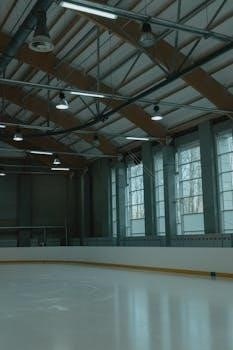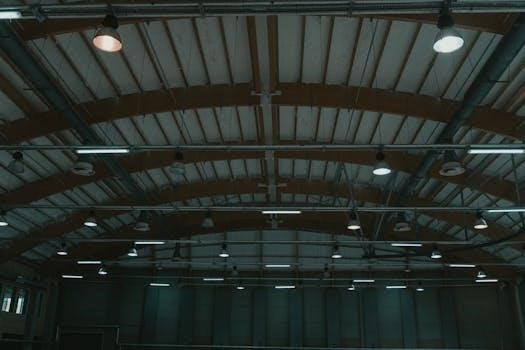Lumbar Spinal Stenosis Exercises PDF⁚ A Comprehensive Guide
This guide introduces the use of exercise for lumbar spinal stenosis. Understanding the conditions these exercises target helps in applying them effectively to increase mobility and strengthen muscles.
Understanding Lumbar Spinal Stenosis
Lumbar spinal stenosis (LSS) involves the narrowing of spaces in the lower back where nerves pass through, leading to nerve compression. Degenerative changes, such as disc herniation, bone spurs, and thickened ligaments, are common causes. These age-related changes affect bones, joints, and spinal discs, causing the spinal canal to narrow.
This narrowing can lead to neurogenic claudication, significantly decreasing walking capacity and impacting physical and mental well-being. Symptoms of spinal stenosis can include lower back pain and leg pain. Understanding the anatomy and the degenerative processes involved is crucial for effective management and exercise planning.
Regular exercises and stretches are often recommended as a conservative treatment to relieve pain and improve mobility.
Causes of Lumbar Spinal Stenosis
Lumbar spinal stenosis primarily arises from age-related degenerative changes within the spine. These changes encompass several factors, including the development of bone spurs, disc herniation, and thickening of the spinal ligaments. As we age, the intervertebral discs may lose height and bulge, contributing to the narrowing of the spinal canal.
Bone spurs, or osteophytes, can form along the edges of vertebrae, further encroaching upon the space available for nerves. Additionally, the ligaments that support the spine can thicken and harden over time, a condition known as ligamentum flavum hypertrophy. All these factors contribute to the compression of the spinal cord and nerve roots, leading to the symptoms associated with lumbar spinal stenosis.
Genetic predisposition and lifestyle factors may also influence the rate and severity of these degenerative processes.

Benefits of Exercise for Lumbar Spinal Stenosis
Regular exercise can increase spinal mobility, strengthen hip muscles for walking and standing, and stretch thigh muscles to improve posture. These exercises are safe to try at home.
Increasing Spinal Mobility
Spinal mobility exercises are crucial for managing lumbar spinal stenosis. Regular performance enhances flexibility and reduces stiffness; Lumbar rotation exercises, done lying on your back, gently roll your knees from side to side. Pelvic tilts, also on your back with bent knees, involve gently tilting your pelvis. These movements should be slow and controlled.
Forward bending exercises while seated can stretch the lower back. Single knee-to-chest stretches improve flexibility. These exercises alleviate pressure on the spinal cord and nerve roots. They also promote better posture and reduce pain. Remember to maintain proper form and avoid overexertion.
Consistency is key; regular exercise is essential for sustained improvement. Starting slowly and gradually increasing repetitions helps prevent injury. Listen to your body and stop if pain increases. These exercises aim to restore normal range of motion and alleviate symptoms.
Strengthening Hip and Thigh Muscles
Strengthening hip and thigh muscles is essential for managing lumbar spinal stenosis. Stronger muscles support the spine, improving stability and reducing strain. These exercises help with walking and standing, alleviating pain and improving mobility. Effective exercises include leg raises and hip extensions, which target key muscle groups.
Begin with simple exercises and gradually increase resistance. Proper form prevents injury and maximizes benefits. Focus on controlled movements and engage the core for added stability. Strengthening these muscles enhances posture, reducing pressure on the spinal nerves. Regular exercise improves overall functional capacity.
Consider incorporating exercises that also improve balance and coordination. Consistent training leads to increased strength and endurance. These exercises complement spinal mobility exercises, providing comprehensive support. Remember to consult with a physical therapist for personalized guidance. They can tailor a program to your specific needs and limitations.

Key Exercises for Lumbar Spinal Stenosis (PDF Resources)
This section outlines key exercises to alleviate lumbar spinal stenosis. These exercises, often detailed in PDF resources, focus on improving spinal mobility, strengthening supporting muscles, and reducing nerve compression for better function.
Pelvic Tilts
Pelvic tilts are foundational exercises to improve lumbar mobility and stability. To perform a pelvic tilt, lie flat on your back with knees bent and feet flat on the ground. Gently tilt your pelvis backward, flattening your lower back against the floor, engaging abdominal muscles. Hold this position briefly.
Then, gently arch your lower back, creating a small space between your back and the floor. Focus on a slow, controlled movement, concentrating on the lower back leading the movement. This exercise helps relieve pressure.
Regular pelvic tilts can help manage symptoms of spinal stenosis. Repeat this exercise ten to fifteen times, ensuring your movements are slow and controlled, paying attention to keeping your back relaxed. Consider consulting with a physical therapist for proper form.
Lumbar Rotation
Lumbar rotation exercises enhance spinal mobility and flexibility, which are essential for managing lumbar spinal stenosis symptoms. To perform lumbar rotation, lie on your back with your knees bent and feet flat on the floor; Keep your shoulders flat on the ground.
Gently roll your knees to one side, keeping your upper body still. Only move as far as you feel comfortable, avoid forcing the movement. Return to the starting position and repeat on the other side. This exercise helps improve rotation.
Perform this lumbar rotation slowly and in a controlled manner, focusing on the movement in your lower back. Repeat this exercise ten to fifteen times on each side. If you experience any pain, stop immediately and consult with a healthcare professional. Regular practice can help maintain spinal mobility and reduce stiffness.
Single Knee to Chest Stretch
The single knee to chest stretch is a beneficial exercise for individuals with lumbar spinal stenosis, designed to alleviate pressure on the spinal cord and nerve roots. To begin, lie on your back on a flat, stable surface, ensuring your back is relaxed and flat. Bend your knees.
Gently pull one knee towards your chest, holding it with your hands. Keep the other leg bent with your foot flat on the floor, or straighten it to deepen the stretch. Hold the stretch for 20-30 seconds, breathing deeply. You should feel a gentle stretch in your lower back and hip.
Release the leg slowly and return to the starting position. Repeat with the other leg. Perform this exercise three to five times on each leg, up to three times a day. This stretch helps to increase spinal mobility. If you experience any increase in pain, discontinue the exercise.
Forward Bending Exercises
Forward bending exercises, also known as flexion exercises, are crucial for relieving pain and pressure associated with lumbar spinal stenosis. These exercises aim to create more space within the spinal canal, reducing nerve compression. A simple forward bending exercise can be performed while sitting in a chair.

Begin by sitting upright with your knees slightly apart. Slowly bend forward from your hips, letting your arms hang towards the ground. Keep your movements controlled. You should feel a gentle stretch in your lower back. Hold this position for 15-30 seconds, breathing deeply to relax your muscles.
Gradually return to an upright seated position. Repeat this exercise 5-10 times, as tolerated. Another variation can be done standing. Start standing upright. Gently bend forward from your waist, keeping your knees slightly bent to avoid strain. Avoid forcing the movement; only bend as far as comfortable. These exercises promote spinal mobility.

Important Considerations When Exercising
When undertaking exercises for lumbar spinal stenosis, it’s vital to prioritize safety and effectiveness. Proper form, technique, and customization are essential. Consulting with a professional ensures exercises align with individual needs and limitations.
Proper Form and Technique
Maintaining proper form and technique is crucial for safe and effective exercise when addressing lumbar spinal stenosis. Correct execution maximizes benefits while minimizing the risk of injury. Begin each exercise slowly, concentrating on controlled movements. Avoid jerky or rapid motions that could strain the spine.
For example, when performing pelvic tilts, ensure the back remains relaxed and flat against the ground. In lumbar rotation, gently roll the knees side to side within a comfortable range. With single knee-to-chest stretches, pull the knee towards the chest while keeping the lower back relaxed.
If adding the arm in this exercise, coordinate the movement with the leg, extending the opposite arm forward as the leg moves. Standing rotation should be performed upright, moving the arm smoothly without twisting the lower back excessively.
Always listen to your body and stop if you experience sharp or increasing pain. Consistent, mindful execution of each exercise will yield better results and protect your spine.
Customization of Exercises
Tailoring exercises to individual needs is essential for effectively managing lumbar spinal stenosis. Customization should consider the patient’s specific symptoms, severity of stenosis, and overall physical condition. Start with a thorough assessment to identify limitations and pain triggers.
Modify exercises to accommodate these factors, ensuring comfort and safety. For instance, reduce the range of motion in lumbar rotations if it causes discomfort. Adjust the intensity of stretches like single knee-to-chest based on individual flexibility. Pelvic tilts can be adapted by focusing on small, controlled movements.
Consider incorporating chair-based versions of standing exercises if balance is an issue. Gradually increase repetitions and duration as tolerance improves, always monitoring for pain. Regularly reassess and adjust the exercise plan to match progress and changing needs.
This personalized approach ensures the exercises remain beneficial and prevents aggravation of symptoms, promoting long-term adherence and improved outcomes. Remember, consistency is key, but adaptation is crucial.
When to Consult a Professional
Consulting a healthcare professional is crucial when dealing with lumbar spinal stenosis. Seek expert advice before starting any exercise program, especially if you’re newly diagnosed. A physical therapist can assess your condition, identify limitations, and tailor exercises to your specific needs.
Consult a professional immediately if you experience new or worsening symptoms, such as increased pain, numbness, weakness, or loss of bowel or bladder control. These could indicate nerve compression requiring prompt medical attention. Also, consult if exercises cause persistent pain exceeding 3/10 or fail to provide relief after a few weeks.
A doctor can rule out other potential causes of your symptoms and recommend appropriate treatment options. Furthermore, if you have other health conditions like heart disease or diabetes, consulting a professional is essential to ensure the exercises are safe and don’t exacerbate those conditions.
Regular check-ins with a healthcare provider are advisable to monitor progress and adjust your exercise plan accordingly. Professional guidance ensures safe and effective management of lumbar spinal stenosis.
